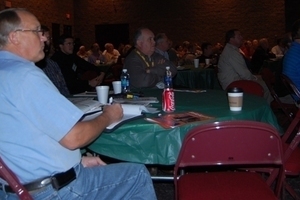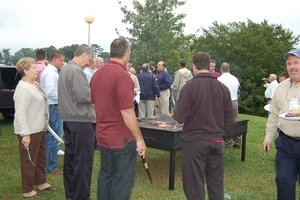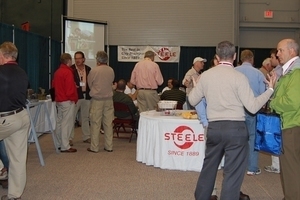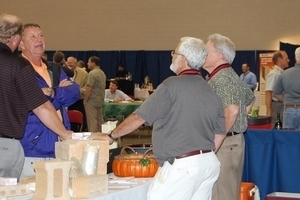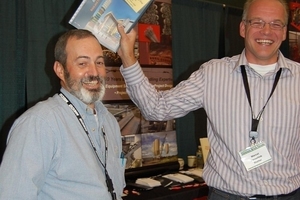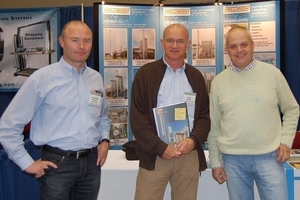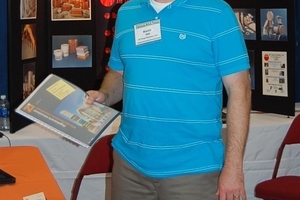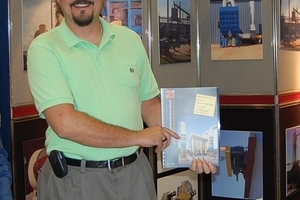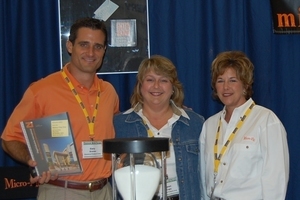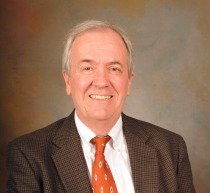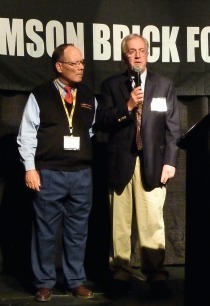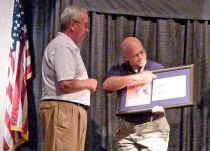Clemson Brick Forum 2009 dedicated to "Greener Bick Manufacturing"
North America's brick & tile industry has been drastically hit by the economic crisis. Heavy clay sales, particularly in the housing sector, have dropped dramatically. The impacts were clearly being felt at the 55th Clemson Brick Forum, where attendance was down by roughly 100 this year from last year's 500 or so participants. Confronting the crisis head on, the forum focused on "Greener Brick Manufacturing" as a topic of great future importance, since North America is showing waxing interest in ecologically appropriate, sustainable construction. As usual, of course, the event also included, in proven manner, papers and presentations concerning brick & tile manufacture and plant / apparatus engineering.
1 Introduction
For the second time in a row now, the forum was held at the Anderson Sports and Entertainment Center in Anderson, S.C. In the meantime, the presentations have been made available as a webcast for the reduced price of roughly €106 (or about $150), and employees of companies that are members of the U.S. National Brick Research Center get a special discount.
With a view to acquainting non-technical personnel with the subject of sustainability, sales and marketing personnel from the heavy clay industry were able to make use of a special one-day registration for Monday's events centering on "Environment-Conscious Production".
Opening on Sunday evening, the accompanying exhibition offered lots of news from the supplier sector. Despite the crisis and the need to cut corners, most of the traditionally participating companies showed up again and demonstrated their solidarity with the forum even in these bad times. A few new companies also participated. However, it was easy to see in the exhibition hall that overall attendance was down.
2 Topics
2.1 Sustainability / "Green Bricks"
Scott Johnston, this year's keynote speaker, spoke on "green architecture". As founder of the Johnston Design Group (2001), Scott Johnston heads a group of architects committed to environmentally sustainable design. After presenting a number of impressive examples of green brick architecture, he held dialog with a brick to point out its options and opportunities. His upshot: Bricks are to houses like bark to trees.
Geoff Edgell of Ceram Building Products (UK) told the audience what British brick makers are up to, and how aggressively they are touting the advantages of sustainable products. Edgell made it clear that sustainability is an important thing and must be dealt with no matter what an individual producer may think about it.
For Neal Cunningham, representing Cunningham Bricks, it is important for manufacturers to offer individual products and propagate "green" new names for their bricks to help convince home builders and communities.
Gregg Borchelt from the Brick Industry Association (BIA) gave a rundown of their activities. In addition to publications devoted to "bricks and sustainability" for home builders, home owners and members of the association, BIA also drafts brochures for architectural colleges. They also bestow a prize for brick architecture and, in cooperation with the National Brick ResearchCenter, provide training for masons and people with similar trades.
Acme Brick's Bill Daidone reported on the application potential of recycled materials for brick making. To start with, all open questions should be clarified in an environment protocol: How much savings can be achieved? Would additive x improve the product's properties? Are any permits needed? What does the additive cost, and how (big) is it packaged? How high are the shipping costs, and what is the cost overall?
Greg Grabert, ClemsonUniversity, delved into the subject of recycling-material certification: how it works and what it costs.
Frank Appel from Hans Lingl Anlagenbau und Verfahrenstechnik spoke on large, insulation-filled bricks and how increasingly stringent thermal insulation standards for buildings can be met by filling bricks with pearlite, granulated minerals or mineral wool. He explained the relevant Unipor Group and Thermoplan facilities in Germany.
Another representative of ClemsonUniversity, John Sanders, outlined the potentials of modeling insulative bricks: How to optimize their core hole geometry, fill the holes, and make use of phase change materials.
The Leadership in Energy and Environmental Design (LEED) system for the holistic evaluation and certification of buildings, developed by the U.S. Green Building Council (USGBC), is becoming increasingly important and accepted - and was the subject of a presentation by Wayne Green of Boral Bricks. Following a general explanation of the certification process, he exemplified its application for Boral's new plant in Terre Haute, Indiana.
Ted Corvey of Pine Hall Brick compared the life-cycle costs of clay pavers and competitive products. While clay pavers cost more at first, the comparison improves as time passes. After 30 years, they end up saving between 17% and 30 %. Corvey appealed to planners not to judge this sustainable material solely on the basis of its initial cost, but to also consider its advantages for the next generation.
The focal point of General Shale Brick's Jim Bryja was the permeability of clay pavers.
Caitlin Rowlands and Ashley Kettner, both of Signode Brick Industry Packaging Systems, reported on recyclable packaging systems.
Next, John Bufford, Acme Brick, elucidated his company's "green" marketing methods. At trade fairs, this brick producer appears with a "green" brick, and their American sales personnel receive pertinent training. Bufford presented 10 practical strategies for "green" marketing according to the slogan "from the earth for the earth".
Is there a future for biomass in brick manufacture? That question was posed by Brad Cobbledick of Brampton Brick. After characterizing biomass per se, he compared several types of biomass and explained how biogas is generated.
Jason Pence presented the Acme Brick Sustainability Program. Doing things like using energy efficient engines and checking the oil at regular intervals to perhaps extend their service life can help minimize our impact on nature by optimizing our consumption of energy and raw materials.
2.2 New plants, major upgrades and manufacturing
Richard Scott of British American Refractories Inc. opened the afternoon session with a presentation of refractory innovations, including some new, low-weight products.
Don Denison, Denison Inc., explained the new SoftMud plant at Watsontown Brick by way of a virtual tour and relevant machinery data.
Andreas Lingl, Hans Ling Anlagenbau und Verfahrenstechnik, presented the British plant Measham. He recounted the technical details and explained how much importance was attached to energy efficiency, including an energy wise dryer and kiln.
Tony Frazier, General Shale Brick, investigated some problems that can crop up when a plant's output is reduced, since both costs and efficiency are directly affected.
Representing Acme Brick, Steve Howard demonstrated how any number of different formats and, as a result, a "stone look" can be achieved by varying the cutter specifications.
Speaking for Boral Bricks, Greg Camp showed how municipal waste can be used to generate biogas. Taking the Terre Haute plant as an example, he illuminated the use of landfill gas (LFG) and the project's implementation with the help of structural details and timetables.
2.3 The Jim Frederic Roast
After soaking up all those reports, the attendees gathered under the auspices of Pine Hall Brick's Harold Newman, as master of ceremonies, to celebrate Jim Frederic, the soon-to-retire Brick Center man, with a roast. During his almost 13 years with the Brick Center, Jim Frederic turned its testing service function into a unique, high-impact resource. His service to ClemsonUniversity and the Center has extended into many other areas, too. For example, he has guided numerous students through their projects, and many of them call him "Professor Frederic". Finally, he has also been good at leading and advancing the Center's employees.
2.4. Manufacturing, Environment and Performance
Terry Beverly, speaking for General Shale Brick, told the audience all about their new brick-making plant in Spring City, from the planning and property development phase all the way up to the turnkey state, and from pit to preparation and on to the kiln. His final conclusion: "Always be critical of your own plans, and always be open to change!"
Acme Brick's Lynn Burchfield gave some good pointers on reducing the fuel consumption of old kilns. They can be optimized via DataPaq curves, incl. kiln pressure curve. The resultant measures, like installing new burners, modifying the ignition signal, retrofitting a cooling system for the kiln car lower decks, replacing the old burner lines, etc. - all add up to a 15 % drop in fuel costs.
Carl Sutherland, Dynaplus, surveyed the presently available range of pulsating combustion systems and then presented and explained the DynaPlus system and its design and function. This system, he said, not only achieves very good uniformity of temperatures, but also helps conserve fuel.
Clark Kindrick of Boral Bricks topicalized the use of landfill gas at Boral's Union City plant. He called attention to the fact that using landfill gas makes it necessary to convert the burners for methane fuel instead of natural gas.
Another Boral Bricks man, Brian Taylor, posed the question: "Do peanut shells make good fuel?" At the Phenix City plant, though, wood scrap is being used as fuel with much success, not only in terms of gas saved but also with regard to product quality.
Tommy Scalf, General Shale Brick, gave a brief but very informative synopsis of the long-term raw-material securance situation, from the surveying of existing resources to costing & accounting and haulage to plant.
Goeff Roberson, Pine Hall Brick, explained how a sand return system can save money.
Also from Pine Hall Brick, Harold Newman reported on the use of waste glass for reducing the firing temperature, fuel consumption and emissions.
Richard Murphy introduced Acme Brick's reserve exploration process. He explained how exploration and development is attended to, including the ascertainment of exploitable clay deposits and how to determine how long the raw materials will last for a particular production output rate.
Larry DiGirolamo, Belden Brick, reported on a system for checking the dimensional accuracy of fired products, including the requisite work procedures and test techniques, i.e., how to gather and represent the data and draw up reports.
„MACT – one more time“ was the topic broached by Terry Schimmel, Boral Bricks. Schimmel provided an overview of pertinent activities between 2002 and 2007, standards newly adopted in 2008, and standards to expect in the future.
Brian Christenson, Acme Brick, came to the conclusion that the best way to reduce NOx emissions is to reduce fuel consumption.
The dismantling of a used gas scrubber and its reconstruction for a new kiln at General Shale Brick was the focal point of a paper presented by Martha West. She explained all the steps of disassembly and reconstruction and what it all cost. By re-using the old plant, the company saved some $181,000.
Gregg Borchelt from Brick Industry Association expounded on seismic testing of brick masonry and the effects of different modes of construction and types of anchorage, and surveyed the various seismic zones in the U.S.
Rick J. Conner of Masonry Cosmetics Inc. wrapped up the last session with a presentation of products for surface treatment of brick masonry.
The next Clemson Forum will take place October 3 - 5, 2010.
The National Brick Research Center/Clemson University
100 Clemson Research Blvd. IAnderson, SC 29625 I USA
T +1 86 46 56 10 94 I F +1 86 46 56 10 95
bdenis@clemson.edu Iwww.brickandtile.org

